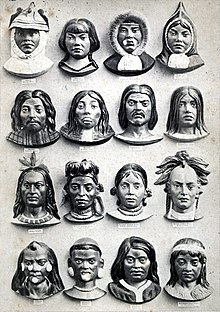Race (sociology)
The term race or racial group refers to dividing the human species into groups. The most widely used human racial types are those based on visual traits (such as skin color, cranial, facial features, or type of hair).[1]

Modern biology says that there is only one human race (biology).[2][3]: 360 But the word race also has a meaning in sociology. Many people react in one way if they see a white person and in another way if they see a black person. That's why census forms sometimes ask people to describe their ethnic origin. It is a way of asking "what racial group do you think you are?".
History
changeIn the 19th century and in the early 20th century, many scientists divided human beings into three races. White people were called "Caucasoid race", black people were called "Negroid race", and the people of East Asia and Southeast Asia were called "Mongoloid race".
There was much prejudice in this way of looking at the world. The Europeans and Asians both regarded themselves as superior to the other skin colors. Racism, a non-scientific theory or ideology, was that a particular race was superior or inferior. It argued that in the races that make up the human race, there are deep, biologically determined differences. It also states races should live separately and not intermarry. A supporter of racism is called a racist. These attitudes supported the horrors of African slavery, Apartheid, segregation and the Jim Crow laws, Nazism and Japanese imperialism.
Recent genetic studies show that the skin color in a population may change a lot over as few as 100 generations, or about 2,500 years.[4]
Social darwinism and race
changeSocial darwinism refers to the idea that competition is active among all individuals, or groups.[5]
It is a social adaptation of the theory of natural selection as proposed by Charles Darwin. Natural selection explains success in animal populations as the outcome of competition between individuals and groups for limited resources. This idea is popularly known as "survival of the fittest", a term first used by Herbert Spencer.[6]
Fascist movements have commonly held social Darwinist views of nations, races, and societies. In Nazi Germany, the Nazis used social Darwinism to promote their racialist idea of the German nation was part of the Aryan race and believed in the competition of races.[7] The Nazis tried to strengthen the ‘Aryan race’ in Germany by murdering those they regarded as inferior. By this they meant Jews, Slavs, Roma, homosexuals, and disabled people.
Pictures
change-
A racially segregated bus station in Durham, North Carolina, 1940. The Jim Crow Laws racially separated parts of America between Blacks and Whites.
-
A billiard hall for only African Americans, in Memphis, Tennessee, 1939.
-
The cafe has two entry doors for two rooms: one for "Whites" only and "Coloureds" only.
-
An African-American youth at a drinking ‘coloured only’ water fountain in a courthouse lawn in Halifax, North Carolina, 1938.
-
A group of white people who are demonstrating for white pride.
Related pages
changeSources
change- ↑ Bamshad, Michael and Steve E. Olson. "Does race exist?", Scientific American (10 November 2003).
- ↑ American Association of Physical Anthropologists (27 March 2019). "AAPA Statement on Race and Racism". American Association of Physical Anthropologists. Retrieved 19 June 2020.
- ↑ Templeton A. 2016. Evolution and notions of human race. In Losos J. & Lenski R. (eds) How evolution shapes our lives: essays on biology and society (pp. 346-361). Princeton; Oxford: Princeton University Press. doi:10.2307/j.ctv7h0s6j.26. This view reflects the consenus among American anthropologists: Wagner, Jennifer K.; Yu, Joon-Ho; Ifekwunigwe, Jayne O.; Harrell, Tanya M.; Bamshad, Michael J.; Royal, Charmaine D. (February 2017). "Anthropologists' views on race, ancestry, and genetics". American Journal of Physical Anthropology. 162 (2): 318–327. doi:10.1002/ajpa.23120. ISSN 0002-9483. PMC 5299519. PMID 27874171.
- ↑ Your family may once have been a different color by Robert Krulwich. Morning Edition, National Public Radio. 2 Feb 2009.
- ↑ Johnson, D. Paul (2008). "The historical background of social darwinism". Contemporary Sociological Theory. Berlin: Springer. pp. 492. ISBN 978-0387765211.
In the social realm the competitive struggle may be among individuals or among different groups within society, different societies, or different racial or ethnic populations.
- ↑ Mayr, Ernst 2002. The biology of race and the concept of equality. Daedalus. MIT Press on behalf of American Academy of Arts & Sciences. 31 (1): 89–94. JSTOR 20027740 [1]
- ↑ Hawkins, Mike. 1997. Social Darwinism in European and American thought, 1860-1945: nature as model and nature as threat. Cambridge: Cambridge University Press. 282 & 284